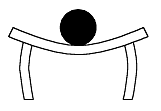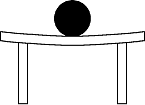Gravity-Table Equilibrium Demystified
©2006 Darel Rex Finley. This complete article, unmodified, may be freely distributed for educational purposes.
In elementary physics classes, the following example is often given:

A 12 lb. bowling ball is at rest on a table. The ball exerts a 12 lb. force downward (by gravity), but doesn’t move,
because the table is exerting a 12 lb. force upward that exactly counterbalances the weight of the bowling ball.
Since the two forces are in equilibrium, nothing is moving.
This example raises an interesting question: How does the table know when to exert the 12 lb. force upwards and when
not to? If the table weighs only 10 lbs. (suppose it is made of lightweight but very sturdy aluminum), then it would
fly up in the air when the bowling ball is removed, unless it knows to stop pushing up when the ball isn’t there.
Further, how does the table know to exert exactly 12 lbs. of force upward, rather than 11 lb. or 13 lb.?
Apparently, a bit more explaining is in order, and unfortunately many physics classes fail to address these
questions.
Table Deformation
To understand what is going on here, look at the case of a rubber table that can bend easily. When there is nothing
on the table, it is not deformed and exerts no force in any particular direction.

Now we place a bowling ball on the rubber table. The table doesn’t “know” that this has happened, and so
exerts no force upwards; therefore the ball will move down. But as soon as it does, it deforms the shape of
the table. As the table deforms, it starts exerting an upward force as it tries to return to its normal shape.
The more the table is deformed, the more strongly it pushes up. When the deformation of the table becomes severe
enough so that it is pushing up with a 12 lb. force, the weight of the ball is exactly counterbalanced and the ball stops
moving downward. Equilibrium has been reached.

What happens when we remove the ball? Again the table doesn’t “know” that the ball is gone, so it
continues pushing up with a 12 lb. force. This unbalanced force causes the surface of the table to move
up. But as it does so, the table is returning to its normal shape and the force diminishes until it stops
altogether. Rather than fly up in the air, the table just moves up enough to lose its deformation and then
stops.
Suppose we do this same experiment with a table made of much stiffer, stronger rubber? The same thing will happen,
but the deformation will be very slight, because of the strength of the stiffer rubber.

If the table is made of wood or aluminum, the same thing still happens, but the deformation of the table is so
slight as to be invisible to the human eye. The table knows when to push up, and with how much force to push up, by
how much it is currently deformed. When you place a bowling ball on an aluminum table, the ball does move down at
first, but only a microscopic distance — then the table’s microscopic deformation causes it to exert an upward force
equal to the weight of the ball.
Questions? Suggestions? Send me an
e-mail!
Quicksort |
Point-in-polygon |
Mouseover menus |
Gyroscope |
Osmosis |
Polarizer experiment |
Gravity-table equilibrium |
Calculus without calculus |
Overlapping maze



